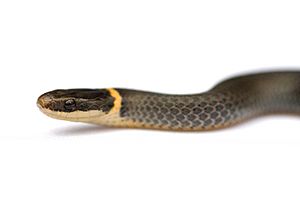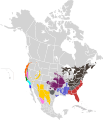Ring-necked snake facts for kids
Quick facts for kids Ring-necked snake |
|
|---|---|
 |
|
| Conservation status | |
| Scientific classification | |
| Genus: |
Diadophis
|
| Species: |
punctatus
|
| Synonyms | |
The ring-necked snake (scientific name: Diadophis punctatus) is a small snake found in North America. It gets its name from the bright ring of color around its neck. This ring can be yellow, orange, or red.
These snakes live in many parts of the United States, central Mexico, and southeastern Canada. Ring-necked snakes are nocturnal, meaning they are most active at night. They are a little bit venomous, but their venom is not strong enough to hurt people. They are also very shy and usually do not bite humans. When a ring-necked snake feels scared, it curls its tail to show off its bright belly.
Scientists believe there are many ring-necked snakes in the wild. However, they have not studied them closely enough to know the exact number. The ring-necked snake is the only type of snake in its group, called a genus. There are 14 different kinds, or subspecies, of ring-necked snakes.
Contents
What Do Ring-Necked Snakes Look Like?
Ring-necked snakes usually have dark bodies, like gray, black, or olive green. They always have a bright, colorful ring around their neck. This ring is often yellow, orange, or red. Their bellies are also brightly colored, matching the neck ring.
Snakes living in different places can be different sizes. Adult ring-necked snakes are usually about 25 to 38 centimeters (10 to 15 inches) long. Young snakes, less than a year old, are about 20 centimeters (8 inches) long. They grow about 2 to 5 centimeters (1 to 2 inches) each year.
Ring-necked snakes have smooth scales on their bodies. They have 15 to 17 rows of scales around the middle of their bodies.
Where Do Ring-Necked Snakes Live?
Ring-necked snakes live in many different kinds of places, called habitats.
- Snakes in northern and western areas often live in open woodlands near rocky hills. They also like wet places where they can hide easily.
- Snakes in southern areas mostly live near rivers and wet areas. This is especially true in dry, or arid, places.
- These snakes like their homes to be a little wet.
- They do not live higher than 2,200 meters (7,200 feet) above sea level.
In colder northern areas, ring-necked snakes might live together in special hiding spots called dens. Many snakes can share one den. They often hide under pieces of wood or rocks. When it gets hot, they might dig holes or burrows to stay cool. They usually live in flat forests.
What Do Ring-Necked Snakes Eat?
Ring-necked snakes mostly eat salamanders, earthworms, and slugs. Sometimes, they also eat small lizards, frogs, and even young snakes of other species. What they eat can depend on where they live.
Ring-necked snakes kill their prey in two ways:
- Constriction: They squeeze their prey until it cannot breathe.
- Envenomation: They use their mild venom to help catch their food.
These snakes usually do not try to hurt bigger animals. If a bigger animal comes near, the snake will often curl up its tail. This shows its brightly colored belly, which can scare away predators.
Who Are Their Predators?
Some other snakes like coral snakes, kingsnakes, and racers eat ring-necked snakes. Sometimes, large spiders or centipedes might eat very young ring-necked snakes.
Subspecies
There are 14 different kinds, or subspecies, of ring-necked snakes. Each one might look a little different or live in a slightly different area.
Gallery
Images for kids
-
A ring-necked snake from Mount Diablo, California.
See also
 In Spanish: Coralillo falso para niños
In Spanish: Coralillo falso para niños









